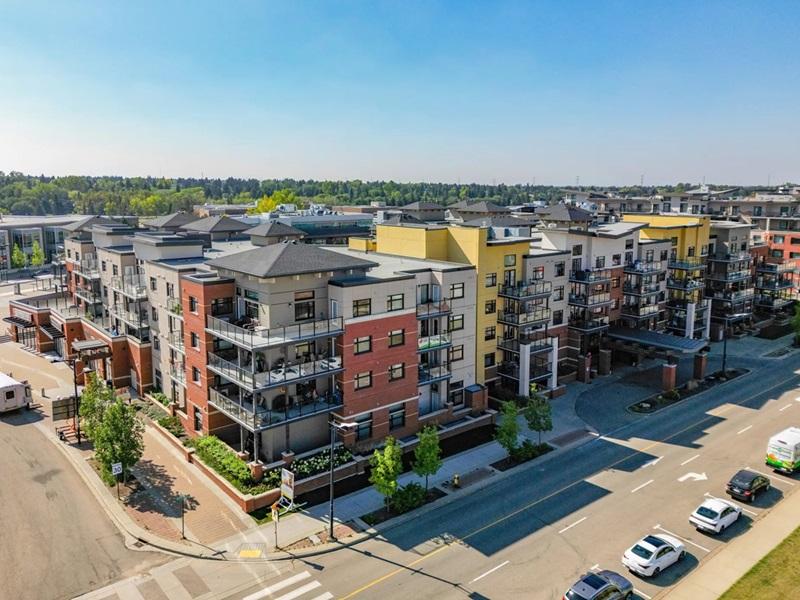
A lack of demand for suburban class-B and -C office space in cities like Toronto will accelerate the number of conversions to apartments, industrial spaces or life science labs in 2023, says JLL Canada CEO Alan MacKenzie.
“The B- and C-class product is really under attack with low demand and declining rental rates,” and owners of suburban office campuses in major cities are thinking it may be best to take a hit, demolish and rezone their properties for other uses, MacKenzie told RENX.
“The worse it gets, the more it’s going to incentivize these owners to consider those conversions.”
Conversions will occur primarily in suburban Toronto where land is so expensive, he said. As an example, he cited KingSett’s Valhalla Village project in Toronto's Etobicoke district, where three suburban office buildings were demolished to make way for purpose-built rental and affordable housing.
JLL has noted about 3.75 million square feet of office space has been completed or is slated for conversion across the country, 70 per cent of which is intended to become apartments.
The many unknowns surrounding the return to the office will persist in 2023, said MacKenzie, who was discussing office trends.
A flight to quality from class-B and -C buildings into class-A or -AAA properties shows no sign of stopping, as tenants seek amenity-rich buildings to attract and retain top talent, he said.
Vacancy rates up as economy slows, remote works continues
Overall vacancy rates are up in all markets – a combination of new space being completed and tenants trying to figure out what their long-term office footprints should look like, he explained.
A slowing economy, rising inflation and interest rates, and bank tightening have stalled the return to office, MacKenzie added, with office users adopting a wait-and-see attitude on the evolution of remote work.
Most major office space users “are just sitting there and going ‘Let’s just see what the first half of 2023 looks like from a business perspective. Let’s not over-force our work populations back to the office,’ because that’s putting pressure on their relationships with employees and there’s fear there will be a backlash.”
Users are also waiting to see whether interest rates drop slightly and inflation stabilizes, and whether office space absorption in the third and fourth quarters of 2023 will normalize.
MacKenzie said “all metrics are actually pretty healthy in our A-class inventory across all markets,” but in B- and C-classes “asking rents have declined and we’re not quite sure where that’s going to finish.”
He said tenants are opting for shorter terms to build flexibility into their leases.
In addition, “we are seeing a general reduction in space as tenants continue to right-size, but on the other hand we have seen some large new leases and consolidations that are a part of the same right-sizing strategy.”
What deals are being done
Tenants are signing deals for smaller spaces, said Luciano D’Iorio, regional president and managing partner at CDNGLOBAL Quebec in Montreal, noting that “the under-10,000-square-foot spaces are more attractive right now” in Montreal.
“People are looking at giving back some space to the landlords. We’re seeing that on the street right now.”
D’Iorio said there are not many options for the smaller tenants seeking spaces of under 10,000 feet, especially turnkey spaces.
“Everyone’s cost-conscious these days; they want to find spaces that are built-out so that you don’t get into construction costs and construction delays. I think that’s going to be what to look at in 2023.”
Acquisitions of office buildings have slowed “tremendously,” MacKenzie said, because rising interest rates have lowered the amounts buyers are willing to pay and, in many cases, sellers “are not desperate enough to sell at the price buyers are willing to offer.”
Institutional investors are waiting to see what happens in the equity and bond markets and how that might affect their ability to buy real estate over the next six to 12 months.
“So much in their macro world needs to be discovered before they get back into buying and expanding," MacKenzie noted. "It’s a private buyers’ market.”
While institutional money for suburban office buildings “has fallen off the table,” MacKenzie noted Montreal-based Groupe Mach and Groupe Petra have been exceptions: The companies have been successful at value-buying suburban office buildings from very motivated vendors.
“There is some entrepreneurial capital that believes that if they buy it low enough, reinvest a limited amount of money into the buildings over the next 12 to 24 months, that when the market turns, they can make quite a good rent on releasing at that time.”
Bid, ask gulf remains wide
MacKenzie will be watching whether the gap between what vendors are willing to sell for and buyers are willing to pay grows.
Over the last two quarters, several owners of suburban class-B and -C buildings have taken their properties off the market after receiving bids significantly below expectations: “It will be interesting to watch if that pattern continues in 2023.”
In Montreal, office vacancy rates are hovering around 17 per cent, D’Iorio said, higher than most other major cities excluding Calgary.
That can be explained in part through strict COVID-19 rules in Quebec, with curfews that lasted until May.
As a result, “employers really haven’t had a chance to test what their employees want and how they want to go about with the new normal.”
D’Iorio suspects office vacancy rates in Montreal will increase slightly over the next 12 to 18 months as National Bank’s new 1.1 million-square-office building at 800 Saint-Jacques St. W. comes onto the market.
In addition, it remains uncertain what governments will do with their office spaces – although the federal government has now indicated it wants employees back in their workspaces two to three days per week.
However, longer-term prospects for downtown Montreal office space are good, he said, with McGill College Avenue set to become a pedestrian street, sidewalk widening work on Ste. Catherine St. continuing and the opening of the REM light-rail system.










